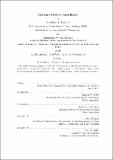| dc.contributor.advisor | Stephan E. Kolitz and Dimitris J. Bertsimas. | en_US |
| dc.contributor.author | Paynter, Jonathan L. (Jonathan Lawrence) | en_US |
| dc.contributor.other | Massachusetts Institute of Technology. Technology and Policy Program. | en_US |
| dc.date.accessioned | 2014-11-04T20:28:14Z | |
| dc.date.available | 2014-11-04T20:28:14Z | |
| dc.date.issued | 2014 | en_US |
| dc.identifier.uri | http://hdl.handle.net/1721.1/91296 | |
| dc.description | Thesis: S.M., Massachusetts Institute of Technology, Sloan School of Management, Operations Research Center, 2014. | en_US |
| dc.description | Thesis: S.M. in Technology and Policy, Massachusetts Institute of Technology, Engineering Systems Division, Technology and Policy Program, 2014. | en_US |
| dc.description | This electronic version was submitted by the student author. The certified thesis is available in the Institute Archives and Special Collections. | en_US |
| dc.description | "June 2014." Cataloged from student-submitted PDF version of thesis. | en_US |
| dc.description | Includes bibliographical references (pages 139-141). | en_US |
| dc.description.abstract | A feature of many conflicts is the presence of a border that separates an area of on-going military operations from an area that the enemy can use permissively. This thesis considers analytic techniques for planning military operations designed to interdict enemy forces crossing the border. Specifically, this thesis presents optimization-based methods for scheduling patrolling units and for positioning ground sensors in support of those patrolling units. These methods could serve as the framework for a tactical-level decision support tool designed to assist military planners assigned to border regions with resource allocation recommendations and trade-off comparisons. We propose tractable mixed integer optimization formulations for these solutions based on a network model of the routes in the region, operational constraints on the abilities of the patrolling units, and estimates of enemy force movements. Additionally, we develop robust extensions to these formulations that allow the model to account for a degree of enemy intelligence by incorporating the uncertain nature of the enemy movement estimates into the formulation. We evaluate the solutions to these formulations using simulations that account for different realizations of the uncertain enemy movement. This includes cases where the realized enemy movement closely matches the estimates made in the model and cases where the realizations are very different from the model. Additionally, we provide a modified greedy heuristic to the scheduling formulation that can serve as a tool for dynamically retasking a patrol to interdict enemy forces in real-time after a sensor detects enemy movement. Current planning for these operations are conducted by a staff with no decision making analytic tools. We approximate a version of this current planning method with an algorithm and show that our method outperforms it with both the deterministic and robust formulations. We compare the deterministic and robust formulations and demonstrate a process for choosing between the formulations, along with an explanation of the utility of the robust formulation. | en_US |
| dc.description.statementofresponsibility | by Jonathan L. Paynter. | en_US |
| dc.format.extent | 141 pages | en_US |
| dc.language.iso | eng | en_US |
| dc.publisher | Massachusetts Institute of Technology | en_US |
| dc.rights | M.I.T. theses are protected by copyright. They may be viewed from this source for any purpose, but reproduction or distribution in any format is prohibited without written permission. See provided URL for inquiries about permission. | en_US |
| dc.rights.uri | http://dspace.mit.edu/handle/1721.1/7582 | en_US |
| dc.subject | Operations Research Center. | en_US |
| dc.subject | Engineering Systems Division. | en_US |
| dc.subject | Technology and Policy Program. | en_US |
| dc.title | Optimized border interdiction | en_US |
| dc.type | Thesis | en_US |
| dc.description.degree | S.M. | en_US |
| dc.description.degree | S.M. in Technology and Policy | en_US |
| dc.contributor.department | Massachusetts Institute of Technology. Engineering Systems Division | |
| dc.contributor.department | Massachusetts Institute of Technology. Operations Research Center | |
| dc.contributor.department | Technology and Policy Program | |
| dc.contributor.department | Sloan School of Management | |
| dc.identifier.oclc | 893480474 | en_US |
